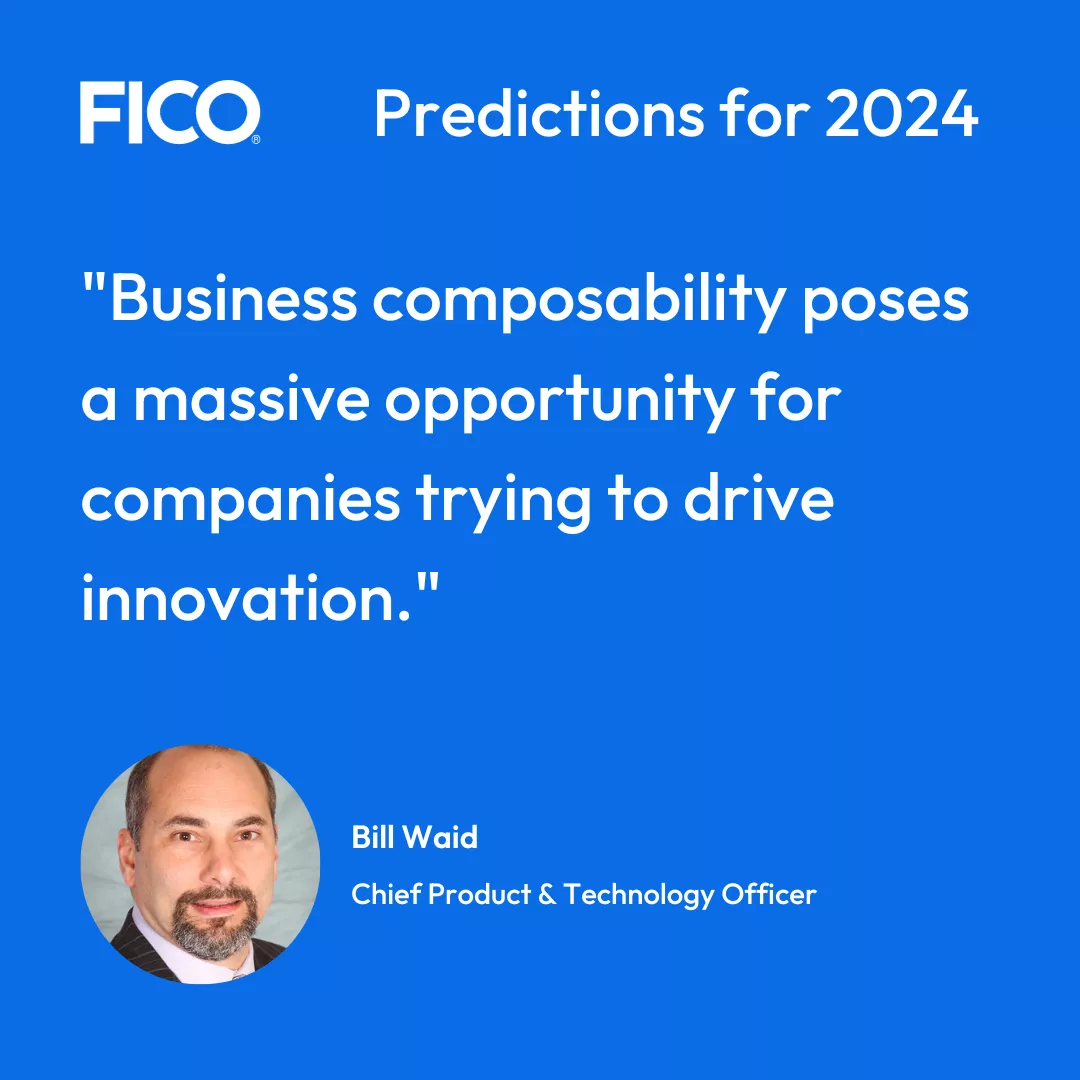Predictions 2024: Six Trends in Digital Transformation and Decisioning
Cloud adoption, AI, API-driven ecosystems and composability are among the trends driving greater value for IT teams and businesses undertaking digital transformation

By and large, digital transformation and IT leaders have much to be proud of in 2023. Digital transformation projects appear to be gaining traction after years of wheel-spinning, and for traditional players the onslaught by all-digital upstarts and new technologies appear to be subsiding as major banks and insurers get their digital acts together.
Every FICO Platform client I met with over the past year reported impressive progress towards attaining – and surpassing – their business processes improvements, digital transformation business outcomes, and delivering more compelling customer experiences. And industry watchers from all corners have reached the consensus that artificial intelligence and enterprise decisioning platforms together provide the promising foundation for organizations seeking to achieve digital transformation and leverage the competitive advantages their data poses.
So what’s in store in digital technologies for 2024?
1. Accelerated Digital Transformation and Cloud Adoption
Building on early success and business ROI realized through digital transformation, the path forward is to achieve greater revenue growth through clear roadmaps that leverage digital technologies to fulfill long-term visions. This poses a two-front challenge: (1) they must squeeze as much value as possible from the digitization of legacy systems without disrupting business operations, (2) they must simultaneously deploy new technologies to build the technological foundation on which their organization will rely for future growth. Given the overarching and ambitious goals of effective digital transformation strategies, operational artificial intelligence-enabled decisioning platforms have never been more important.
2. Greater Emphasis on “Data in Motion”
Just as water can be solid, gas, or liquid depending on atmospheric conditions, information can take different forms, depending on operating conditions. Data can be at rest (in a database) in use (by active applications), or “in motion”… constantly streaming in real-time from one point to another over the internet or private business network via mobile services, shared applications, digital requests, instant payments, IOT events, etc.
As the name implies, data in motion is a moving target, changing at the speed of the Internet; this makes it inherently more difficult to control, manage, and protect. It demands the ability to securely stream, analyze, and act on information the instant it is generated and received. Major banks and insurers setting their customer experience and digital transformation strategies need to make data in motion a high priority: it requires a massively-scalable platform to orchestrate millions of simultaneous data streams from an array of sources, front-end customer experiences, and corporate back-end operations in real-time… and then make accurate, personalized, and instantaneous customer decisions based on the most current information available.
3. API-Driven Open Ecosystems
Open ecosystems are not new in the digital transformation realm, but they are a proven, efficient, modular way of fostering information-based partnerships, both internally – in support of enterprise systems of collaboration across organizational functions – and externally to accelerate innovation through co-creation with 3rd party partners. In 2024, you will start to see the emergence of open ecosystems based on enterprise decisioning platforms and related digital technologies, using APIs and artificial intelligence to unify processing across multiple organizations, culminating in an integrated customer experience.
These will not only facilitate the rapid creation of new information-based products and services but will allow for cross-enterprise and cross-ecosystem business processes and decisioning solutions that can be developed and deployed in a fraction of the time required by traditional approaches. Through digitization and providing a more flexible, API-driven way of managing decision strategies and business operations, companies’ digital transformation strategies can flourish: open ecosystems will unleash innovation, lead to the creation of new dynamic B2B opportunities focused on accelerating customer value, and ultimately smarter, faster, more profitable decisions across the enterprise.

4. Business Composability
Business composability poses a massive opportunity for companies seeking successful digital transformation and trying to drive innovation; it helps to achieve of business competitiveness through agility derived through digitization of legacy systems and enhanced digital technologies. In concert with an API-driven paradigm, business composability puts complex business innovation into the hands of business stakeholders, enabling a digital collaboration that drives differentiation at a digital pace.
Premised on an established software engineering design pattern, composability leverages modular “components” or “building blocks” that can be shared, combined, and recombined, to enable assembly of a network of complex business capabilities that meet and can be rapidly adjusted to market changes. Non-technical employees across the enterprise can easily define functional capabilities and quickly assemble their own services, intuitively create their own processes and event handlers, conduct what-if scenario analysis, and review the detailed visualizations they produce… accelerating digital transformation and improving customer experiences without impacting IT resources.
A complete, end-to-end set of composable capabilities can address and accelerate a wide spectrum of use cases across the customer lifecycle in a transparent, explainable, and tightly governed manner.
5. Unlocking the Power of Artificial Intelligence
For years, businesses have been trying to extend the focus of artificial intelligence and machine learning beyond a set of development tools and digital technologies for building models; they have been endeavoring to transparently operationalize AI and machine learning in live business processes as part of a concerted digital transformation effort. In 2024, there will great strides in ensuring artificial intelligence is no longer an isolated venture; it will be a ubiquitous, essential ingredient in decision automation and governance, while offering full transparency and auditability.
In this mainstream, embedded capability, digitization and artificial intelligence will empower businesses to leverage computers for what they excel at — processing, analyzing, and managing data — but doing so in a manner that heightens the customer experiences while remaining explainable, ethical, and increasingly efficient. Responsible AI will be the byword.
6. Hyper-Personalization at Scale
The end goal of digital transformation and all the trends mentioned above is to create compelling customer experiences that bring value to businesses and consumers. In a B2C context, differentiation and loyalty stem from the ability to deliver compelling, hyper-personalized customer experiences and tailored offerings at scale. This requires the foundational plumbing for data in motion, which drives artificial intelligence-powered insights; this, in turn, makes the goals of digital transformation – better decision making, more efficient business processes, and smarter real-time interactions, experiences, and individualized product offerings – attainable.
Hyper-personalization is the next inflection point in digital value creation: employing digital technologies to meet consumers in their moment of need with individualized value expressed through experiences, journeys, and offerings.
In 2024, the most forward-looking B2C companies around the world will leverage these digital transformation trends by using operational decision platforms to connect legacy systems and high-velocity data; these will drive useful, actionable, and measurable digital transformation strategies that enable smarter, faster, more profitable decisions. It will also allow them to quickly and easily embody their digital transformation strategies into unique customer experiences and upselling/ cross-selling opportunities that boost satisfaction, retention, and lifetime value… the pinnacle of successful digital transformation.
Learn How FICO Platform Can Power Your Digital Transformation
- Explore innovation with FICO Platform
- See customers discuss their use of FICO Platform
- Watch the video “FICO® Platform: Applied Intelligence, when and where it matters”
- Read the whitepaper “FICO® Enterprise Intelligence Network: Redefining the next generation of applied intelligence”
- Read the article from The Journal of Digital Banking, “How Financial Services Leaders Are Using Enterprise Intelligence to Optimize Efficiency Ratios”
- Watch FICO Platform in action with the story of your everyday consumer, Digital Jane
Popular Posts

Business and IT Alignment is Critical to Your AI Success
These are the five pillars that can unite business and IT goals and convert artificial intelligence into measurable value — fast
Read more
FICO® Score 10T Decisively Beats VantageScore 4.0 on Predictability
An analysis by FICO data scientists has found that FICO Score 10T significantly outperforms VantageScore 4.0 in mortgage origination predictive power.
Read more
Average U.S. FICO Score at 717 as More Consumers Face Financial Headwinds
Outlier or Start of a New Credit Score Trend?
Read moreTake the next step
Connect with FICO for answers to all your product and solution questions. Interested in becoming a business partner? Contact us to learn more. We look forward to hearing from you.
